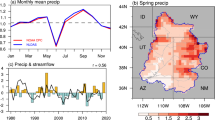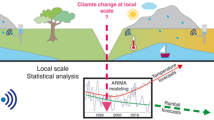Abstract
The coastal waters of the southeastern USA contain important protected habitats and natural resources that are vulnerable to climate variability and singular weather events. Water clarity, strongly affected by atmospheric events, is linked to substantial environmental impacts throughout the region. To assess this relationship over the long-term, this study uses an artificial neural network-based time series modeling technique known as non-linear autoregressive models with exogenous input (NARX models) to explore the relationship between climate and a water clarity index (KDI) in this area and to reconstruct this index over a 66-year period. Results show that synoptic-scale circulation patterns, weather types, and precipitation all play roles in impacting water clarity to varying degrees in each region of the larger domain. In particular, turbid water is associated with transitional weather and cyclonic circulation in much of the study region. Overall, NARX model performance also varies—regionally, seasonally and interannually—with wintertime estimates of KDI along the West Florida Shelf correlating to the actual KDI at r > 0.70. Periods of extreme (high) KDI in this area coincide with notable El Niño events. An upward trend in extreme KDI events from 1948 to 2013 is also present across much of the Florida Gulf coast.






Similar content being viewed by others
References
Ault, D. N. (2006) Temporal and spatial distribution of chlorophyll on the West Florida Shelf. University of South Florida Theses and Dissertations. Paper 3864
Barnes BB, Hu C (2015) Cross-sensor continuity of satellite-derived water clarity in the Gulf of Mexico : insights into temporal aliasing and implications for long-term water clarity assessment. IEEE Trans Geosci Remote Sens 53:1761–1772
Barnes BB, Hu C, Schaeffer BA, Lee Z, Palandro DA, Lehrter JC (2013) MODIS-derived spatiotemporal water clarity patterns in optically shallow Florida keys waters: a new approach to remove bottom contamination. Remote Sens Environ 134:377–391
Barnes BB, Hu C, Holekamp KL, Blonski S, Spiering BA, Palandro D, Lapointe B (2014) Use of Landsat data to track historical water quality changes in Florida keys marine environments. Remote Sens Environ 140:485–496
Barnes BB, Hallock P, Hu C, Muller-Karger F, Palandro DA, Walter C, Zepp R (2015) Prediction of coral bleaching in the Florida keys using remotely sensed data. Coral Reefs 34:491–503
Beale MH, Hagan MT, Demuth HB (2014) Neural Network ToolboxTM User’s Guide, R2014a. White Paper. The Mathworks Inc.
Causey BD (2002) The role of the Florida keys National Marine Sanctuary in the South Florida ecosystem restoration initiative, pp. 883–894. In: Porter JW, Porter KG (eds) The Everglades, FloridaBay, and coral reefs of the Florida keys, an ecosystem source book. CRC Press, Boca Raton
Conmy, R.N. (2008) Temporal and spatial patterns in optical properties of colored dissolved organic matter on Florida’s gulf coast: shelf to stream to aquifer. University of South Florida Theses and Dissertations, Paper 187
Diaconescu E (2008) The use of NARX neural networks to predict chaotic time series. WSEAS transactions on computer. Research 3(3):182–191
Fourqurean JW, Robblee MB (1999) Florida Bay: a history of recent ecological changes. Estuaries 22:345–357
Greening HS, Cross LM, Sherwood ET (2011) A multiscale approach to seagrass recovery in Tampa Bay, Florida. Ecol Restor 29:82–93. doi:10.3368/er.29.1-2.82
Greening H, Janicki A, Sherwood ET, Pribble R, Johansson JOR (2014) Ecosystem responses to long-term nutrient management in an urban estuary: Tampa Bay, Florida, USA. Estuar Coast Shelf Sci 151:A1–A16. doi:10.1016/j.ecss.2014.10.003
Hagan MT, Menhaj M (1994) Training feed-forward networks with the Marquardt algorithm. IEEE Transactions on Neural Networks 5(6):989–993
Hu C, Muller-Karger FE (2007) Response of sea surface properties to hurricane Dennis in the eastern Gulf of Mexico. Geophys Res Lett 34:L07606. doi:10.1029/2006GL028935
Janicki, A., Wade, D., & Pribble, R. J. (2000) Developing & establishing a process to track the status of chlorophyll—a concentrations and light attenuation to support seagrass restoration goals in Tampa Bay. Tampa Bay Estuary Program Technical Report # 04–00
Jiang N (2011) A new objective procedure for classifying New Zealand synoptic weather types during 1958–2008. Int J Climatol 31(6):863–879
Kalnay E, Kanamitsu M, Kistler R, Collins W, Deaven D, Gandin L, Iredell M, Saha S, White G, Woollen J, Zhu Y, Chelliah M, Ebisuzaki W, Higgins W, Janowiak J, Mo KC, Ropelewski C, Wang J, Leetmaa A, Reynolds R, Jenne R, Joseph D (1996) The NCEP/NCAR 40-year reanalysis project. Bull Am Meteorol Soc 77:437–471
Lee CC, Sheridan SC (2011) A six-step approach to developing future synoptic classifications based on GCM output. Int J Climatol 32(12):1792–1802
Lee Z, K-P D, Arnone RA (2005) A model for the diffuse attenuation coefficient of downwelling irradiance. J Geophys Res 110:C02016
Lee Z, Lubac B, Werdell PJ, Arnone RA (2009) An update of the quasi-analytical algorithm (QAA_v5). International Ocean Color Group Software Report. Available from: http://www.ioccg.org/groups/Software_OCA/QAA_v5.pdf
Lirman D, Schopmeyer S, Manzello D, et al. (2011) Severe 2010 cold-water event caused unprecedented mortality to corals of the Florida reef tract and reversed previous survivorship patterns. PLoS One 6:e23047. doi:10.1371/journal.pone.0023047
Liu Y, Weisberg RH (2005) Patterns of ocean current variability on the West Florida shelf using the self-organizing map. J Geophys Res 110:C06003. doi:10.1029/2004JC002786
Lohrenz SE, Fahnenstiel GL, Redalje DG, Lang GA, Dagg MJ, Whitledge TE, Dortch Q (1999) Nutrients, irradiance, and mixing as factors regulating primary production in waters impacted by the Mississippi River plume. Cont Shelf Res 19:1113–1141
Maier HR, Dandy GC (2000) Neural networks for the prediction and forecasting of water resources variables: a review of modelling issues and applications. Environ Model Softw 15:101–124
Maier HR, Dandy GC (2001) Neural network based modelling of environmental variables: a systematic approach. Math Comput Model 33:669–682
Mathworks (2014) www.mathworks.com/help/nnet/ref/trainlm.html?searchHighlight=trainlm as accessed on 4 December 2014
May R, Dandy G, Maier H (2011) Review of input variable selection methods for artificial neural networks, Artificial Neural Networks-Methodological Advances and Biomedical Applications, Prof. Kenji Suzuki (Ed.), ISBN: 978–953–307-243-2, InTech. Available from: http://www.intechopen.com/books/artificialneural-networks-methodological-advances-and-biomedical-applications/review-of-input-variable-selectionmethods-for-artificial-neural-networks
NOAA (2015) NOAA’s Earth Systems Research Laboratory’s Bimonthly MEI Index. http://www.esrl.noaa.gov/psd/enso/mei/table.html as retrieved on 7 December 2015
NOAA National Centers for Environmental Information (2015) Billion Dollar Weather and Climate Disasters. https://www.ncdc.noaa.gov/billions/mapping
Olden JD, Jackson DA (2002) Illuminating the “black box”: a randomization approach for understanding variable contributions in artificial neural networks. Ecol Model 154:135–150
Patt FS, Barnes RA, Eplee RE, Franz BA, Robinson WD, Feldman GC, Bailey SW, Gales J, Werdell PJ, Wang M, Frouin R, Stumpf RP, Arnone RA, Gould, R. W. J, Martinolich PM, Ransibrahmanakul V, O’Reilly JE, Yoder JA (2003) Algorithm Updates for the Fourth SeaWiFS Data Reprocessing, NASA Tech Memo 2003–206892, Volume 22. In: Hooker SB, Firestone ER (eds) SeaWiFS Postlaunch Technical Report Series
Pirhalla, D.E., Sheridan, S.C., Ransibrahmanakul, V., Lee, C.C. (2014) Assessing cold-snap and mortality events in South Florida coastal ecosystems: development of a biological cold stress index using satellite SST and weather pattern forcing. Estuaries and Coasts (Accepted, in press). DOI: 10.1007/s12237–014-9918-y
Sheridan SC (2002) The redevelopment of a weather-type classification scheme for North America. Int J Climatol 22:51–68
Sheridan SC, Lee CC (2014) Synoptic climatology. In: Warf B (ed) Oxford bibliographies in geography. Oxford University Press, New York City, USA. doi:10.1093/OBO/9780199874002-0088
Sheridan SC, Pirhalla DE, Lee CC, Ransibrahmanakul V (2013) Evaluating linkages of weather patterns and water quality responses in South Florida using a synoptic climatological approach. J Appl Meteorol Climatol 52(2):425–438. doi:10.1175/JAMC-D-12-0126.1
Short FT, Wyllie-Escheverria S (1996) Natural and human-induced disturbance of seagrasses. Environ Conserv 23(1):17–27
SPSS (2001) The SPSS two-step cluster component: a scalable component to segment your customers more effectively. White paper, technical report, SPSS, Chicago, Illinois, USA
Acknowledgments
This research was supported by the National Aeronautics and Space Administration’s (NASA’s) Research Opportunities in Space and Environmental Sciences (ROSES) funding opportunity, Development and Testing of Potential Indicators for the National Climate Assessment, Award NNX13AN31G. The authors would like to thank Dr. Michael J. Allen from the Department of Political Science and Geography at Old Dominion University for his contributions to the early portions of this project.
Author information
Authors and Affiliations
Corresponding author
Rights and permissions
About this article
Cite this article
Lee, C.C., Sheridan, S.C., Barnes, B.B. et al. The development of a non-linear autoregressive model with exogenous input (NARX) to model climate-water clarity relationships: reconstructing a historical water clarity index for the coastal waters of the southeastern USA. Theor Appl Climatol 130, 557–569 (2017). https://doi.org/10.1007/s00704-016-1906-7
Received:
Accepted:
Published:
Issue Date:
DOI: https://doi.org/10.1007/s00704-016-1906-7




